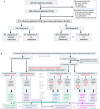Similar severity of influenza primary and re-infections in pre-school children requiring outpatient treatment due to febrile acute respiratory illness: prospective, multicentre surveillance study (2013-2015)
- PMID: 34983428
- PMCID: PMC8724639
- DOI: 10.1186/s12879-021-06988-7
Similar severity of influenza primary and re-infections in pre-school children requiring outpatient treatment due to febrile acute respiratory illness: prospective, multicentre surveillance study (2013-2015)
Abstract
Background: Influenza virus infections in immunologically naïve children (primary infection) may be more severe than in children with re-infections who are already immunologically primed. We compared frequency and severity of influenza virus primary and re-infections in pre-school children requiring outpatient treatment.
Methods: Influenza-unvaccinated children 1-5 years of age presenting at pediatric practices with febrile acute respiratory infection < 48 h after symptom onset were enrolled in a prospective, cross-sectional, multicenter surveillance study (2013-2015). Influenza types/subtypes were PCR-confirmed from oropharyngeal swabs. Influenza type/subtype-specific IgG antibodies serving as surrogate markers for immunological priming were determined using ELISA/hemagglutination inhibition assays. The acute influenza disease was defined as primary infection/re-infection by the absence/presence of influenza type-specific immunoglobulin G (IgG) and, in a second approach, by the absence/presence of subtype-specific IgG. Socio-demographic and clinical data were also recorded.
Results: Of 217 influenza infections, 178 were due to influenza A (87 [49%] primary infections, 91 [51%] re-infections) and 39 were due to influenza B (38 [97%] primary infections, one [3%] re-infection). Children with "influenza A primary infections" showed fever with respiratory symptoms for a shorter period than children with "influenza A re-infections" (median 3 vs. 4 days; age-adjusted p = 0.03); other disease characteristics were similar. If primary infections and re-infections were defined based on influenza A subtypes, 122 (87%) primary infections (78 "A(H3N2) primary infections", 44 "A(H1N1)pdm09 primary infections") and 18 (13%) re-infections could be classified (14 "A(H3N2) re-infections" and 4 "A(H1N1)pdm09 re-infections"). Per subtype, primary infections and re-infections were of similar disease severity. Children with re-infections defined on the subtype level usually had non-protective IgG titers against the subtype of their acute infection (16 of 18; 89%). Some patients infected by one of the influenza A subtypes showed protective IgG titers (≥ 1:40) against the other influenza A subtype (32/140; 23%).
Conclusions: Pre-school children with acute influenza A primary infections and re-infections presented with similar frequency in pediatric practices. Contrary to expectation, severity of acute "influenza A primary infections" and "influenza A re-infections" were similar. Most "influenza A re-infections" defined on the type level turned out to be primary infections when defined based on the subtype. On the subtype level, re-infections were rare and of similar disease severity as primary infections of the same subtype. Subtype level re-infections were usually associated with low IgG levels for the specific subtype of the acute infection, suggesting only short-time humoral immunity induced by previous infection by this subtype. Overall, the results indicated recurring influenza virus infections in this age group and no or only limited heterosubtypic antibody-mediated cross-protection.
Keywords: Children; Disease severity; IgG; Immunology; Influenza.
© 2021. The Author(s).
Conflict of interest statement
ASt, JGL and ASa received research grants for studies, lecturing fees or honoraria for expert meetings from GlaxoSmithKline and/or other vaccine manufacturers during previous years. RSO was an employee of GlaxoSmithKline at the time of the study. AK, BW, and CP declare no conflict of interest.
Figures

References
Publication types
MeSH terms
Grants and funding
LinkOut - more resources
Full Text Sources
Medical

